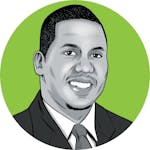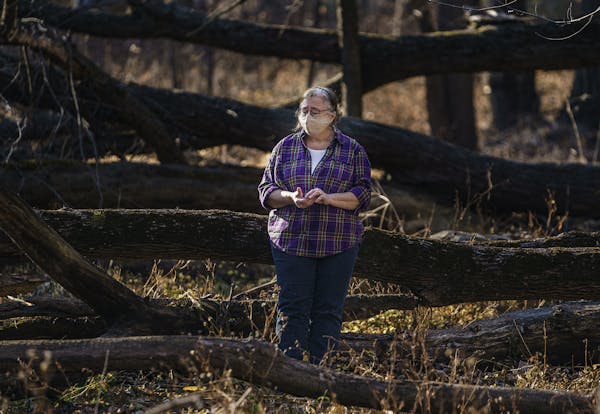She is trying. And she is struggling.
That is a common combination throughout a pandemic that's removed kids from classrooms and placed a substantial burden on teachers, staffers, parents and students across this country.
As the 15-year-old African American high school student in St. Paul explained the hurdles attached to her distance-learning experience, she also expressed her frustrations.
"It has been really hard," she told me. "I try to double my workload some days. It can get pretty overwhelming. I feel guilty that I'm not passing English."
Each morning, I walk downstairs and offer a Morgan Freeman-like monologue that aims to encourage my daughters before they log in with their tablets and get ready for school. Eight months into this experiment, my mini-TED Talks tend to lack flavor. My girls seem annoyed. I get it. I'm tired of hearing myself talk, too.
Some days, I fail to acknowledge the emotions my daughters must work through before they're asked to find the energy to complete their coursework. I don't always know what success looks like or what's reasonable to expect of them during this moment.
This is difficult for them, too. I'm not trained. And my basement isn't a classroom.
When I read the recent reports that nearly 40% of St. Paul high school students have failing grades, I understood the implications of those numbers and the circumstances that can affect them. I also knew they included multiple Black and brown students and students who hail from impoverished communities.
"Some challenges I'm having are staying motivated to do work, even to get out of bed," another student of color who attends a St. Paul high school told me. "I would want adults to know that this situation is different for everyone and they should try to be empathetic."
In the world of education, students of color are often assigned a number at an early age. We are surrounded by statistics that highlight our collective challenges and minimize our collective successes. Here are the number of Black kids who can read by the time they're in third grade. The percentage of Black students who received a passing mark on the state's standardized tests. The number of Black students who failed to complete high school in Minneapolis, St. Paul and the surrounding suburbs.
The great fight for any family of color in this state is to magnify the brilliance, potential and progress of our children against the undercurrent of discouraging statistics in Minnesota, which has wrestled with one of America's worst achievement gaps.
That's why I worry the pandemic will swallow more children who look like mine as students get left behind in whatever a return to "normal" looks like in coming years. This is not the first time in America that students of color and those from resource-deprived communities have been this vulnerable.
After the Brown v. Board of Education decision in 1954, white people here and elsewhere made a conscious choice to position their kids for success in the educational system that prioritizes them.
There were contentious lawsuits and movements to push forward with desegregation in the Twin Cities in the years that followed the Supreme Court ruling. The current achievement gap in this state is the byproduct of a decadeslong investment in the futures of white kids in private, public and charter schools, an investment largely inaccessible to a substantial portion of children of color or low income.
While Minnesota's white and Black families have both endured the challenges within the distance learning experience, history suggests minority children will emerge as the most vulnerable group in the most uncertain chapter most of us have experienced.
I'm fortunate my daughters are surrounded by a tribe of parents, teachers, grandparents and friends whom I know will support them in the coming years as they try to recover whatever they've lost this year. Every kid deserves as much. But I'm not convinced this state will fill the void for those children who need that additional support and assistance, especially those who are not affluent and white. Some of those kids will look like my daughters.
There will be fights in 2021 and beyond with policymakers, educational leaders, parents and community members all attempting to chart a path toward the future. Those conversations will include an abundance of numbers and statistics in the effort to assign blame.
But these children don't need another fight. They need help.
More than anything, they'll need this entire state to make a commitment to their collective success and promise Black and brown kids, who've been forgotten in the past, tangible proof of ongoing support.
I know I can't feel OK simply because my daughters are OK. I know I have to do more.
And it's unfair to expect teachers, already battling the brunt of this, to do this alone. We have to do it together. These students are not "40%." They're our kids in our communities.
The St. Paul high school student who told me she's challenged by her English class said she lost some of the assistance she had at a local homework center when the busing plan ended due to COVID-19.
She added, however, that she was happy someone reached out and told her they cared.
"Honestly, I don't think [40%] is surprising," she said. "I've had friends who've told me how hard it was. I'm trying my best to do the work and make myself proud."
She is trying. And, under these circumstances, she is succeeding.
But she deserves more than a statistic. We owe her and her peers our long-lasting and unyielding compassion.
Myron Medcalf is a local columnist for the Star Tribune. A longtime Minnesota resident, he has previously worked as a news and sports reporter for the Star Tribune and is now a national writer and radio host for ESPN. His column appears in print on Sundays twice a month and also online.

Medcalf: Exonerated of murder, author will speak at our Minneapolis book club about 'life and freedom'
Medcalf: Will plans to restore St. Paul's Rondo replace what was stolen?
Medcalf: Young adults' demand for work-life balance offers lessons for us all

Medcalf: Were up to 200 kids really actively fighting in Roseville?


